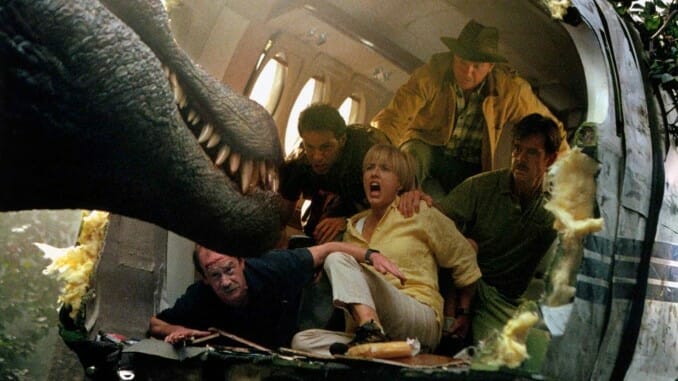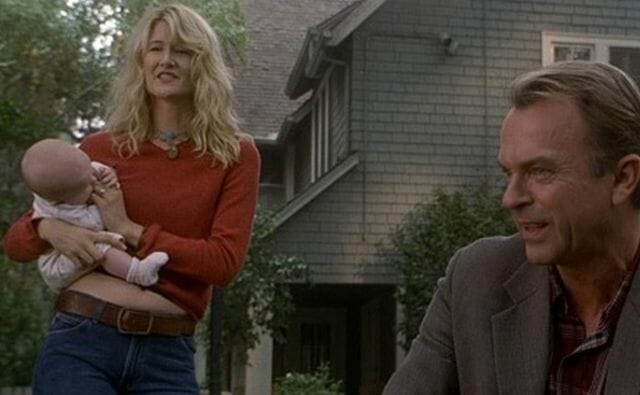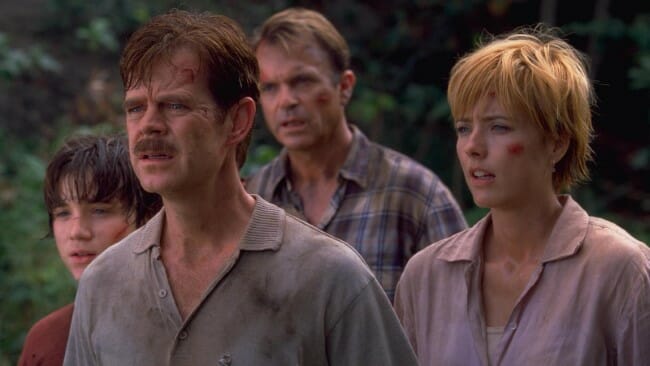Two Decades Later, Jurassic Park 3 Is a Chaotic, Black Sheep Time Capsule
Photos via Universal Pictures Movies Features jurassic park
It may seem hard to believe, in retrospect, as we approach what appears to be a massive opening box office weekend for Jurassic World Dominion, that a return to the Jurassic setting seemed like less than a sure thing back in 2015 as the first Jurassic World lumbered into theaters. That film would go on shatter box office records with a nearly $1.7 billion worldwide take, affirming that yes, people still enjoy a good old-fashioned CGI creature bonanza on the big screen, but it’s important to note that the massive success of Jurassic World wasn’t something that could be taken for granted at the time. Rather, feelings were tentative, and producers were likely concerned that the Jurassic franchise was still mired in a certain brand of existential malaise.
Which is to say, the malaise of 2001’s Jurassic Park 3. The black sheep of the Jurassic franchise, the failure of Joe Johnston’s uninspired return to Isla Sorna put big-budget dinosaur cinema into carbon freeze for roughly 14 years. Just over two decades removed from its summer release, Dr. Alan Grant’s first return to the Jurassic story now stands out for both its narrative oddities and its truly laborious production, which included a screenplay rewritten so many times that it was never actually completed in full while the movie was being filmed. It’s little wonder that Johnston later referred to the experience as “a living hell on a daily basis.”
So in honor of Dominion closing out the latest chapter in the dinosaur saga, let’s reexamine what went so very wrong with the first Jurassic trilogy capper.
A Mesozoic Mess of a Production
Jurassic Park 3 had the distinction of being the first entry in the series not helmed by populist directorial legend Steven Spielberg, who felt stifled by the production challenges of the first two Jurassic films and wanted to pass off the responsibility for a third installment after the mildly disappointing reception of first sequel The Lost World. For this job, he chose friend Joe Johnston of films such as Jumanji and The Rocketeer, with Spielberg intending to supervise the production fairly closely as an executive producer, presumably to ensure a certain tonal consistency. Spielberg, however, would go on to be absent from the set, busy with his own demanding work on 2001’s A.I. Artificial Intelligence, and one has to imagine his guiding hand was sorely missed in the cascading series of misfires that would follow.
The original concept for a Jurassic Park 3 was meant to be generated by Spielberg and author Michael Crichton, but this never came to be. Instead, screenwriter Craig Rosenberg was hired to produce the first version of the Jurassic Park 3 script, eventually turning out a story that “involved teenagers becoming marooned on Isla Sorna.” That script was summarily rejected, and the second crack at a Jurassic Park 3 screenplay was handled by writer Peter Buchman. His script was quite different, and would have simultaneously involved a Dr. Grant storyline on Isla Sorna, and a concurrent “mysterious dinosaur killings on the Costa Rican mainland” storyline. Until almost a month before production began on Jurassic Park 3, this remained the film’s working script.
However, a mere five weeks before filming was slated to begin, Johnston and Spielberg rejected the entire second script from Buchman, calling it unwieldy and overcomplicated. Following a suggestion from screenwriter David Koepp, who had written the first two films—but has no credit on Jurassic Park 3—Spielberg and Johnston decided to vastly simplify the overall scope of Jurassic Park 3 into a more generic “rescue mission” storyline, and hired screenwriters Alexander Payne and Jim Taylor to completely rewrite the script at the last minute. This, despite the fact that $18 million had already been spent on Jurassic Park 3 at this point, with Buchman’s screenplay fully storyboarded and budgeted, and sets already being constructed. The film’s story, meanwhile, was quickly becoming a hodgepodge of elements from all three versions of the screenplay, in order to salvage whatever work had already been completed.
It’s this hurried final leg of production that gave us Jurassic Park 3 elements such as the minimal inclusion of Dr. Ellie Sattler in the story, as her character hadn’t been included in either of the first two scripts by Rosenberg or Buchman. Nor was Laura Dern certain she wanted to return for a role that would essentially be a glorified cameo, until she was reportedly talked into the gig by the presence of Payne and Taylor, who had written her 1996 film Citizen Ruth. Spielberg, meanwhile, suggested the role Ellie would play in “saving” the stranded rescuers from afar, somehow giving Dern both the role of “single day shoot cameo” and “deus ex machina” in the same film.
 She totally pulled off the mom jeans, though.
She totally pulled off the mom jeans, though.
Oh, and if you were wondering why Alan and Ellie were written as having been long since separated? Johnston said the following in an interview of the era: “I didn’t want to see them as a couple anymore.” So if you’ve had that particular retcon stuck in your craw for the last 14 years, know that the director of Jumanji likely made the call.
Back in 2001, though, the belabored Jurassic Park 3 screenplay was then somehow passed back to Peter Buchman for further revisions, who reportedly removed the majority of humor inserted by Payne and Taylor. Production on the film, meanwhile, had already begun, and subsequent complications led to the following incredible factoid: A final draft of the script was never completed during production. Johnston has stated as much himself—just look at this choice cut from a contemporary interview about the film:
We never did have a final script. We did not have a final script until after we wrapped the movie. We shot pages that eventually went into the final script but we didn’t have a document. The joke on the set was it was going to be the wrap gift, everybody got a script. We had a script for the day we were shooting and maybe the next day and sometimes a week ahead of time, but we never had a story that had a beginning, middle and end while we were making the film. We had to go back to Hawaii to shoot the ending because when we were there the first time, we didn’t know what the ending was going to be.
If that sounds to you like an utterly chaotic and stressful way to make a $100 million Hollywood blockbuster, you’d be absolutely correct. Immediately following the release of the film, star William H. Macy effectively threw it under the bus:
The script has been evolving and has been rewritten as we go. And what you want to say is, “Who launched a $100 million ship without a rudder? What kind of idiot is that? And who’s getting fired for this?”
 It’s unknown if it was also clear to Macy how annoying the Kirby family would be as secondary protagonists.
It’s unknown if it was also clear to Macy how annoying the Kirby family would be as secondary protagonists.
The chaotic production was followed by a less than scintillating worldwide release—although Jurassic Park 3 went on to make $368 million worldwide, it was seen as a significant disappointment and much less profitable than even The Lost World. It remains by far the lowest-grossing entry in the series, and it would be 14 years before Universal was able to revive the franchise in its wake.
Derivative and Dissatisfying
Revisiting Jurassic Park 3 in 2022, as I did on a recent weekday evening, is an exercise that highlights the difference between competent filmmaking and inspired filmmaking. For all its production struggles, scriptural consternation and general lack of original ideas, the film is at least coherent throughout, and extremely easy to follow. This is ultimately both a compliment and a detriment, as a simple lack of ambition to tell a story with any deeper meaning or symbolism holds Jurassic Park 3 back. Where the two Spielberg-helmed films offer a rich subtext that critiques corporate America, gender relations and conservationism, Jurassic Park 3 tosses such petty concerns to the winds in favor of mundane action and extremely straightforward narrative objectives. It essentially aspires to nothing more than to put a few monsters on screen, a goal at which it admittedly succeeds.
Consider a seemingly unimportant factor such as runtime, though, and you will begin to feel the constraints of Jurassic Park 3 hemming it in. The first and second films of the series weigh in at 126 and 129 minutes long. Jurassic World and its two sequels, by the way, likewise run 124, 128 and 146 minutes. Jurassic Park 3? It’s 92 minutes long, and that’s including the credits. From start to finish, it’s only 85 minutes from the first images before the credits begin rolling, immediately following the film’s notably abrupt ending, as it transitions directly from the final confrontation with the Velociraptor pack into the U.S. military suddenly rolling aquatic vehicles up onto Isla Sorna. It feels like multiple sequences are missing in there, a testament to the fractured screenplay and the fact that Johnston and co. had literally no idea how the film was going to end while they were in the middle of shooting it. It feels like the film is struggling to limp its way across the finish line, groping for the 90-minute mark that has for so long represented Hollywood’s magical “feature film” boundary in the eyes of executives.
That compression of the story in Jurassic Park 3 wouldn’t matter so much if it was at least delivering novel experiences for the majority of its runtime, but so much of the film feels cannibalized from Spielberg’s initial blockbuster that it takes on an Indiana Jones and the Last Crusade-like tenor. If that film amounted to an overreaction by Spielberg, shamelessly repeating what worked in Raiders of the Lost Ark after audiences failed to appreciate the divergence of Temple of Doom, then Jurassic Park 3 feels much the same, primarily aping the first film after The Lost World attempted to explore a new tone. One might even point to Jurassic Park 3 and its Spinosaurus antagonist as laying the groundwork for the nostalgic retread-fest of the Jurassic World films—Malcolm wondering “Why do they always have to go bigger?” aloud in Dominion’s trailer would have been just as relevant about the third entry in 2001 as it now is in 2022. The more things change, the more they stay the same.
Granted, there are elements of Jurassic Park 3 that were novel for the time, most notably including the Pteranodon aviary sequence, and the further exploration of raptor intelligence that was largely sidestepped in The Lost World, but even those elements seem inconsequential in a film that otherwise just feels like a pale and wan imitation of one of the essential pop cultural touchstones of the 1990s. Compare, for instance, T-Rex car attack of Jurassic Park with the Spinosaurus plane attack sequence of Jurassic Park 3, and the disparity in directorial style between Spielberg and Johnston is never more evident.
The big, animatronic Spinosaurus model is still incredibly impressive and articulated, but it lacks anywhere near the same impact on screen primarily because it’s been filmed so much less effectively. As Spielberg lenses the T-Rex attacking Tim’s car, each movement has the weight and power of a massive, hungry creature behind it as it systematically dismantles the Jeep, and the director lingers on each movement with supreme confidence in the believability of what is being conveyed. The Spinosaurus, on the other hand, is shot in a herky-jerky blur of movement, close-ups and swinging, gnashing teeth, covering up for the fact that there’s no concrete sense of space and choreography in the sequence. The rapid-fire editing splashes images across the scene almost faster than they can be processed, while the camera jitters like the sequence is being filmed by one of the characters. It’s a fundamentally different take on a similar action scene, and one that seems to highlight a filmmaker who feels much less confident in his own tools.
That’s Jurassic Park 3 in a nutshell—a rushed, chaotic screen story that only briefly dallies with new concepts but is largely content to simply rehash series highlights as it provides just enough action to get it past basic standards for viability as an early 2000s blockbuster. In the years since, it has maintained its status as both the worst-received and oddest entry in the series until arguably eclipsed by the “raptors in a haunted mansion” third act of J.A. Bayona’s profoundly eccentric Fallen Kingdom, but at least in the case of the latter it was an expression of its director’s idiosyncratic style. Let that be a lesson to would-be helmers of the Jurassic franchise when it’s inevitably rebooted five years from now: You might want to be sure you have a completed script for your film before you start shooting it, unless you want to suffer Jurassic Park 3’s fate.
Jim Vorel is a Paste staff writer and resident genre geek. You can follow him on Twitter for more film writing.